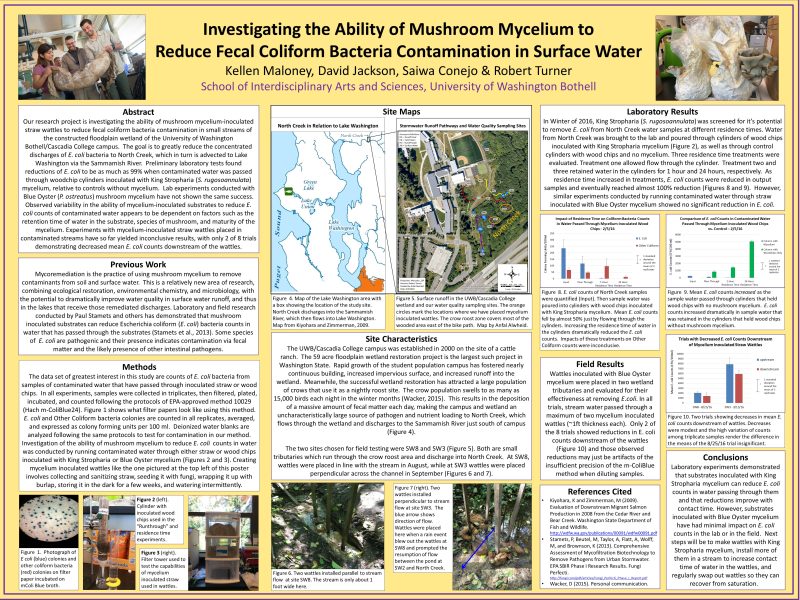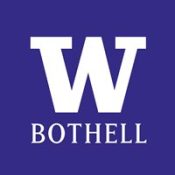Investigating the Ability of Mushroom Mycelium to Reduce Fecal Coliform Bacteria Contamination in Surface Water

Our research project is investigating the ability of mushroom mycelium-inoculated woodchip wattles to reduce fecal coliform bacteria contamination from crows in the runoff of the University of Washington Bothell/Cascadia College campus. This project is funded by a grant from King County. Preliminary laboratory tests found reductions of E. coli to be as much as 99% when contaminated water was passed through woodchip cylinders inoculated with King Stropharia (S. rugosoannulata) mycelium, relative to controls without mycelium. Subsequent experiments directing campus runoff into bigger masses of mycelium-inoculated woodchips have shown mixed results. Observed variability in the ability of mycelium-inoculated substrates to reduce E. coli counts of contaminated water appears to be dependent on factors such as the retention time of water in the substrate, species of mushroom, maturity of the mycelium and how long the mycelium and woodchip medium stays saturated. The experiments for 2020-2021 will focus on the potential for wattles of mycelium-inoculated woodchips to reduce pathogenic bacteria counts and virulence of runoff from the Discovery Hall roof, which is impacted by crow defecation. We will focus on this source of contaminated runoff as the volume and duration of flow from rain events are of a scale that we hope the mycelium in our wattles can handle.
Previous Work
Mycoremediation is the practice of using mushroom mycelium to remove contaminants from soil and surface water. This is a relatively new area of research, combining ecological restoration, environmental chemistry, and microbiology, with the potential to dramatically improve water quality in surface water runoff. Laboratory and field research conducted by Paul Stamets and others has demonstrated that mushroom-inoculated substrates can reduce Escherichia coliform (E. coli) bacteria counts in water that has passed through the substrates (Stamets et al., 2013). Some species of E. coli are pathogenic and their presence indicates contamination via fecal matter and the likely presence of other intestinal pathogens.
Site Characteristics
The UWB/Cascadia College campus was established in 2000 on the site of a cattle ranch. The 59-acre floodplain wetland restoration project is the largest such project in Washington State. Rapid growth of the student population campus has fostered nearly continuous building, increased impervious surface, and increased runoff into the wetland. Meanwhile, the successful wetland restoration has attracted a large population of crows that use it as a nightly roost site. The crow population swells to as many as 15,000 birds each night in the winter months (Wacker, 2015). This results in the deposition of a massive amount of fecal matter each day, making the campus and wetland an uncharacteristically large source of pathogen and nutrient loading to North Creek, which flows through the wetland and discharges to the Sammamish River just south of campus (Figure 4).
Laboratory Results
In the Winter of 2016, King Stropharia (S. rugosoannulata) was screened for its potential to remove E. coli from North Creek water samples at different residence times. Water from North Creek was brought to the lab and poured through cylinders of wood chips inoculated with King Stropharia mycelium (Figure 2), as well as through control cylinders with wood chips and no mycelium. Three residence time treatments were evaluated. Treatment one allowed flow through the cylinder. Treatments two and three retained water in the cylinders for 1 hour and 24 hours, respectively. As residence time increased in treatments, E. coli counts were reduced in output samples and eventually reached almost 100% reduction (Figures 8 and 9).
Conclusions
Laboratory experiments demonstrated that substrates inoculated with King Stropharia mycelium can reduce E. coli counts in water passing through them and that reductions improve contact time.
Student Outcomes
Methods: The data set of greatest interest in this study is counts of E. coli bacteria from samples of contaminated water that have passed through inoculated wood chips. In all experiments, samples were collected in triplicates, then filtered, plated, incubated, and counted following the protocols of EPA-approved method 10029 (Hach m-ColiBlue24). Figure 1 shows what filter papers look like using this method. E. coli and other Coliform bacteria colonies are counted in all replicates, averaged, and expressed as colony-forming units per 100 ml. Deionized water blanks are analyzed following the same protocols to test for contamination in our method.
Investigation of the ability of mushroom mycelium to reduce E. coli counts in water was conducted by running contaminated water through either straw or wood chips inoculated with King Stropharia or Blue Oyster mycelium (Figures 2 and 3). Creating mycelium-inoculated wattles like the one pictured at the top left of this poster involves collecting and sanitizing straw, seeding it with fungi, wrapping it up with burlap, storing it in the dark for a few weeks, and watering intermittently.
Student Responsibilities
Student researchers will take the lead in growing mushroom mycelium in woodchips, making wattles of mycelium-inoculated woodchips, designing an experiment to direct roof runoff through the wattles, assessing the viability of the mycelium before and after experimental runs, collecting water samples before and after passage through the wattles, analyze the E. coli bacteria counts in water samples, and collaborate with Keya Sen in STEM and her research assistants in their studies of the influence of mycelium on the species, virulence and antibiotic resistance of bacteria in water samples.
Collaborators
Keya Sen, School of Science, Technology, Engineering, and Mathematics
Resources and additional content
- Figure 1. Photograph of E. coli (blue) colonies and other coliform bacteria (red) colonies on filter paper incubated on m Coli Blue broth.
- Figure 2 (left). A cylinder with inoculated wood chips was used in the “Runthrough” and residence time experiments.
- Figure 3 (right). Filter tower used to test the capabilities of mycelium inoculated straw used in wattles.
- Figure 4. Map of the Lake Washington area with a box showing the location of the study site. North Creek discharges into the Sammamish River, which then flows into Lake Washington. Map from Kiyohara and Zimmerman, 2009.
- Figure 5. Surface runoff in the UWB/Cascadia College wetland and our water quality sampling sites. The orange circles mark the locations where we have placed mycelium-inoculated wattles. The crow roost zone covers most of the wooded area east of the bike path. Map by Anfal Alwheid.
- Figure 6. Two wattles were installed parallel to stream flow at site SW8. The stream is only about 1 foot wide here.
- Figure 7 (right). Two wattles were installed perpendicular to stream flow at site SW3. The blue arrow shows the direction of flow. Wattles were placed here when a rain event blew out the wattles at SW8 and prompted the resumption of flow between the pond at SW2 and North Creek.
- Figure 8. E. coli counts of North Creek samples were quantified (Input). Then sample water was poured into cylinders with wood chips inoculated with King Stropharia mycelium. Mean E. coli counts fell by almost 50% just by flowing through the cylinders. Increasing the residence time of water in the cylinders dramatically reduced the E. coli counts. The impacts of these treatments on Other Coliform counts were inconclusive.
- Figure 9. Mean E. coli counts increased as the sample water passed through cylinders that held wood chips with no mushroom mycelium. E. coli counts increased dramatically in sample water that was retained in the cylinders that held wood chips without mushroom mycelium.
- Figure 10. Two trials showed decreases in mean E. coli counts downstream of wattles. Decreases were modest and the high variation of counts among triplicate samples renders the difference in the means of the 8/25/16 trial insignificant.
References Cited
- Kiyohara, K and Zimmerman, M (2009). Evaluation of Downstream Migrant Salmon Production in 2008 from the Cedar River and Bear Creek. Washington State Department of Fish and Wildlife. http://wdfw.wa.gov/publications/00091/wdfw00091.pdf
- Stamets, P, Beutel, M, Taylor, A, Flatt, A, Wolff, M, and Brownson, K (2013). Comprehensive Assessment of Mycofiltration Biotechnology to Remove Pathogens from Urban Stormwater. EPA SBIR Phase I Research Results. Fungi Perfecti. http://fungi.com/pdf/articles/Fungi_Perfecti_Phase_I_Report.pdf
- Wacker, D (2015). Personal communication.
